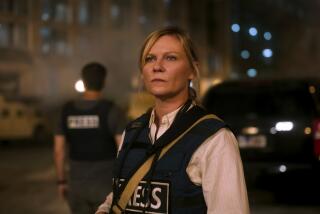Libya blast kills photojournalists Tim Hetherington and Chris Hondros
Reporting from Misurata, Libya, and Los Angeles -- Barely two months ago, combat photographer Tim Hetherington sent out a tweet from the Academy Awards ceremony, where his Afghanistan war film “Restrepo” was up for the best documentary trophy.
“At the #Oscars w/ Josh Fox of @gaslandmovie and director of Wasteland https://ow.ly/i/8Dl6,” he messaged, referring to two of his fellow nominees in the category. The tweet was accompanied by a photo of Hetherington, beaming, in a tuxedo.
On Tuesday, Hetherington sent out a very different report from the shattered and besieged Libyan city of Misurata: “Indiscriminate shelling by Qaddafi forces. No sign of NATO.”
Those starkly dissimilar dispatches reflected two disparate but complementary sides of Hetherington, 41, who was killed Wednesday in an explosion believed to have been caused by a mortar round in Misurata. The rebel-held city in western Libya has been under siege for several weeks by forces loyal to Libyan leader Moammar Kadafi.
The same mortar blast fatally wounded Chris Hondros of Getty Images, a veteran combat photographer whose work appeared on the front page of Wednesday’s edition of the Los Angeles Times, and appears in today’s edition as well.
Hondros, 41, suffered a severe head injury in the blast and was taken to a hospital, where he died several hours later.
Hondros had received multiple awards, including war photography’s highest honor, the 2005 Robert Capa gold medal. He was a Pulitzer Prize finalist for his work in Liberia.
Two other photojournalists were injured in the blast: Michael Brown of the Corbis Agency and Guy Martin of Panos Pictures.
Doctors at Misurata’s Hikma Hospital said that seven rebel fighters and a Ukrainian doctor also were killed Wednesday in shellings, and 120 people were wounded.
Hondros had been taking photographs in Misurata on Wednesday morning under the protection of a rebel militia commanded by a fighter named Salahidin. His photos captured the militia in action as it tried to flush snipers loyal to Kadafi from their hiding spots.
After transmitting the images to his employers at Getty Images, he returned to the front lines with Salahidin and his men in the afternoon.
Hetherington and Hondros were part of a group of six photographers who made their way up a dangerous strip of Tripoli Street, a front line where Kadafi snipers hide in buildings in the rebel-held city.
At some point, at least some of the photographers broke away from Salahidin to get to a safer position, said Guillermo Cervera, a freelance photographer who was among the group. They were hit by shrapnel from a mortar round.
“We were trying to get to a safe place. It was too quiet. It felt dangerous,” said Cervera, who was a few yards away at the time of the blast. “I heard the whoosh of an explosion, and everybody was on the ground.”
Rebels took the photographers to Hikma Hospital.
Hetherington was pallid and bleeding from a bad leg wound, and he had also been hit in the head, Cervera said.
Through his photos, which sometimes straddled the line between journalism and fine art photography, Hetherington sought to bridge the perceptual gap between chaotic events in developing countries and the more privileged worlds of his Western readers. His projects had included multi-screen installations and hand-held device downloads.
Born in Liverpool, England, he studied literature at Oxford University and later returned to college to study photography, according to a biography on his website.
A contributing photographer to Vanity Fair, he lived for eight years in West Africa before making his first trips to Afghanistan a few years ago.
“Restrepo,” which he co-directed with author Sebastian Junger, about a platoon of U.S. soldiers serving in the remote and highly dangerous Korengal Valley of Afghanistan, won the Grand Jury Prize at the Sundance Film Festival last year.
“There is no way to express my devastation and sorrow at the death of my dear friend Tim Hetherington,” Junger said in a statement. “Tim was one of the most courageous and principled journalists I have ever known.”
In Los Angeles, Hetherington’s publicist, Cathy Saypol, said she spoke with him Tuesday night. He told her he was staying in a “safe house” with other journalists and not to worry.
Saypol said hundreds of phone calls and emails had been received from soldiers who knew Hetherington from the Korengal Valley.
Mohammed Zawwam, a local journalist, said Hetherington had talked of wanting to help Misurata’s people and of doing a video project on the conflict.
Most of Misurata is in rebel hands, though it is ringed by Kadafi’s forces, which have superior firepower.
“He was just a good guy, an amazing guy to me,” Zawwam said.
David Courier, a programmer for the Sundance Film Festival who chose “Restrepo” to open last year’s event, said the movie gave “the experience of what it’s like to be at war.” He described Hetherington as “a really humble guy. … Grace is a really good word to describe Tim Hetherington. There was humility and none of that false humility which can sometimes permeate the entertainment industry.”
In a statement, the Hetherington family said, “Tim was in Libya to continue his ongoing multimedia project to highlight humanitarian issues during time of war and conflict. He will be forever missed.”
In an interview in November with the PBS’s “NewsHour,” Hetherington discussed the challenges of reporting on war in “Restrepo.”
“It’s a very slippery thing to try to get out any truisms about war,” he said.
“You know, war is hell, but it’s more than that. And rather than lay down any kind of definitiveness, I just wanted to, to show the texture of it.
“And that meant not just photographing just the combat, but, as you say, the guys, their time off, when war is often very boring. And it’s boredom punctuated by sheer terror.
“And I wanted to capture all of that.”
Hondros, who has covered conflicts in Iraq and elsewhere, was perhaps best known for a series of images he made of shrieking, blood-splattered Iraqi children whose parents had been shot to death by a U.S. Army patrol, reportedly by mistake.
Los Angeles Times photographer Michael Robinson Chavez, who worked overseas with Hondros, said he “was more often than not the smartest photographer in the room. … His intellect was only matched by his ability to make amazing photographs, smart photographs, in horrendous situations.”
Hondros was engaged to be married in August.
Rick Loomis, a Los Angeles Times photographer who had known Hondros for a decade and worked alongside him on several occasions, most recently covering the uprisings in Egypt, described him as “one of the best war photographers of this generation.”
“His images made you stop and made you think about what you were witnessing with him,” Loomis said.
Parker reported from Misurata and Johnson from Los Angeles. Times staff writer Nicole Sperling in Los Angeles contributed to this report.
More to Read
Only good movies
Get the Indie Focus newsletter, Mark Olsen's weekly guide to the world of cinema.
You may occasionally receive promotional content from the Los Angeles Times.







